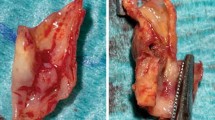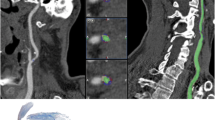Abstract
The aim of this study was to compare delayed-phase computed tomography angiography (CTA) attenuation values with histopathology, in ability to differentiate between fibrous and lipid-rich plaques in an experimental rabbit model. Twelve atherosclerotic rabbits underwent CTA of the abdominal aorta. The scan protocol included early-phase scans (EP), delayed scans at 90 s after contrast injection (DP90s), delayed scans at 10 min after contrast injection (DP10min), and delayed scan with saline infusion (DPSaline). Plaque composition was analyzed by histopathology (% of lipid-rich, fibrous and macrophage areas) and CT attenuation values in Hounsfield units. Using histopathology as the reference standard (n = 119), the overall sensitivity, specificity and accuracy of 64-slice CTA for the detection of plaques was 59, 100 and 79% for the EP scans; 88, 100 and 94% for the DP90s scans; 81, 100 and 90% for the DP10min scans; and 53, 100 and 76% for the DPSaline scans. CT density measurements showed a substantial overlap between fibrous and lipid-rich plaques, and poor correlations with the percentage of macrophage areas in both fibrous and lipid-rich plaques (r = 0.408, and r = 0.333). In delayed-phase 64-slice CTA, DP90s images have the best diagnostic performance for the detection of aortic plaques.





Similar content being viewed by others
References
Waxman S (1999) Characterization of the unstable lesion by angiography, angioscopy, and intravascular ultrasound. Cardiol Clin 17:295–305
Virmani R, Burke AP, Kolodgie FD, Farb A (2002) Vulnerable plaque: the pathology of unstable coronary lesions. J Interv Cardiol 15:439–446
Kolodgie FD, Burke AP, Farb A et al (2001) The thin-cap fibroatheroma: a type of vulnerable plaque: the major precursor lesion to acute coronary syndromes. Curr Opin Cardiol 16:285–292
Goldstein JA, Demetriou D, Grines CL, Pica M, Shoukfeh M, O’Neill WW (2000) Multiple complex coronary plaques in patients with acute myocardial infarction. N Engl J Med 343:915–922
Newby AC, Libby P, van der Wal AC (1999) Plaque instability—the real challenge for atherosclerosis research in the next decade? Cardiovasc Res 41:321–322
Virmani R, Kolodgie FD, Burke AP, Farb A, Schwartz SM (2000) Lessons from sudden coronary death: a comprehensive morphological classification scheme for atherosclerotic lesions. Arterioscler Thromb Vasc Biol 20:1262–1275
Fayad ZA, Fuster V (2001) Clinical imaging of the high-risk or vulnerable atherosclerotic plaque. Circ Res 89:305–316
Caussin C, Ohanessian A, Ghostine S et al (2004) Characterization of vulnerable nonstenotic plaque with 16-slice computed tomography compared with intravascular ultrasound. Am J Cardiol 94:99–104
Schroeder S, Kopp AF, Baumbach A et al (2001) Noninvasive detection and evaluation of atherosclerotic coronary plaques with multislice computed tomography. J Am Coll Cardiol 37:1430–1435
Leber AW, Knez A, Becker A et al (2004) Accuracy of multidetector spiral computed tomography in identifying and differentiating the composition of coronary atherosclerotic plaques: a comparative study with intracoronary ultrasound. J Am Coll Cardiol 43:1241–1247
Pohle K, Achenbach S, Macneill B et al (2007) Characterization of non-calcified coronary atherosclerotic plaque by multi-detector row CT: comparison to IVUS. Atherosclerosis 190:174–180
Schroeder S, Flohr T, Kopp AF et al (2001) Accuracy of density measurements within plaques located in artificial coronary arteries by X-ray multislice CT: results of a phantom study. J Comput Assist Tomogr 25:900–906
Yuan C, Kerwin WS, Ferguson MS et al (2002) Contrast-enhanced high resolution MRI for atherosclerotic carotid artery tissue characterization. J Magn Reson Imaging 15:52–67
Wasserman BA, Smith WI, Trout HH, Cannon RO, Balaban RS, Arai AE (2002) Carotid artery atherosclerosis: in vivo morphologic characterization with gadolinium enhanced double-oblique MR imaging—initial results. Radiology 223:566–573
Cademartiri F, Mollet NR, Runza G et al (2005) Influence of intracoronary attenuation on coronary plaque measurements using multislice computed tomography: observations in an ex vivo model of coronary computed tomography angiography. Eur Radiol 15:1426–1431
Halliburton SS, Schoenhagen P, Nair A et al (2006) Contrast enhancement of coronary atherosclerotic plaque: a high-resolution, multidetector-row computed tomography study of pressure-perfused, human ex vivo coronary arteries. Coron Artery Dis 17:553–560
Nikolaou K, Flohr T, Knez A et al (2004) Advances in cardiac CT imaging: 64-slice scanner. Int J Cardiovasc Imaging 20:535–540
Raff GL, Gallagher MJ, O’Neill WW, Goldstei JA (2005) Diagnostic accuracy of noninvasive coronary angiography using 64-slice spiral computed tomography. J Am Coll Cardiol 46:552–557
Nikolaou K, Becker CR, Flohr T et al (2004) Optimization of ex vivo CT- and MR- imaging of atherosclerotic vessel wall changes. Int J Cardiovasc Imaging 20:327–334
Libby P (2002) Inflammation in atherosclerosis. Nature 420:868–874
van der Wal AC, Becker AE, van der Loos CM, Das PK (1994) Site of intimal rupture or erosion of thrombosed coronary atherosclerotic plaques is characterized by an inflammatory process irrespective of the dominant plaque morphology. Circulation 89:36–44
Hansson GK (2005) Inflammation, atherosclerosis, and coronary artery disease. N Engl J Med 352:1685–1695
Calcagno C, Cornily JC, Hyafil F et al (2008) Detection of neovessels in atherosclerotic plaques of rabbits using dynamic contrast enhanced MRI and 18F-FDG PET. Arterioscler Thromb Vasc Biol 28:1311–1317
Moselewski F, Ropers D, Pohle K et al (2004) Comparison of measurement of cross-sectional coronary atherosclerotic plaque and vessel areas by 16-slice multidetector computed tomography versus intravascular ultrasound. Am J Cardiol 94:1294–1297
Leber AW, Knez A, von Ziegler F et al (2005) Quantification of obstructive and nonobstructive coronary lesions by 64-slice computed tomography; a comparative study with quantitative coronary angiography and intravascular ultrasound. J Am Coll Cardiol 46:147–154
Leber AW, Becker A, Knez A et al (2006) Accuracy of 64-slice computed tomography to classify and quantify plaque volumes in the proximal coronary system; a comparative study using intravascular ultrasound. J Am Coll Cardiol 47:672–677
Chopard R, Boussel L, Motreff P et al (2010) How reliable are 40 MHz IVUS and 64-slice MDCT in characterizing coronary plaque composition? An ex vivo study with histopathological comparison. Int J Cardiovasc Imaging 26:373–383
Viles-Gonzalez JF, Poon M, Sanz J et al (2004) In vivo 16-slice, multidetectorrow computed tomography for the assessment of experimental atherosclerosis: comparison with magnetic resonance imaging and histopathology. Circulation 110:1467–1472
McMahon AC, Kritharides L, Lowe HC (2005) Animal models of atherosclerosis progression: current concepts. Curr Drug Targets Cardiovasc Haematol Disord 5:433–440
Bengel FM (2006) Atherosclerosis imaging on the molecular level. J Nucl Cardiol 13:111–118
Acknowledgments
We are grateful for the technical assistance of Young Min Cho and Nam Hee Park. This study was supported by a faculty research grant of Yonsei University College of Medicine for 2009 (6-2009-0082).
Conflict of interest
None
Author information
Authors and Affiliations
Corresponding author
Rights and permissions
About this article
Cite this article
Hur, J., Kim, Y.J., Shim, H.S. et al. Assessment of atherosclerotic plaques in a rabbit model by delayed-phase contrast-enhanced CT angiography: comparison with histopathology. Int J Cardiovasc Imaging 28, 353–363 (2012). https://doi.org/10.1007/s10554-011-9801-x
Received:
Accepted:
Published:
Issue Date:
DOI: https://doi.org/10.1007/s10554-011-9801-x




